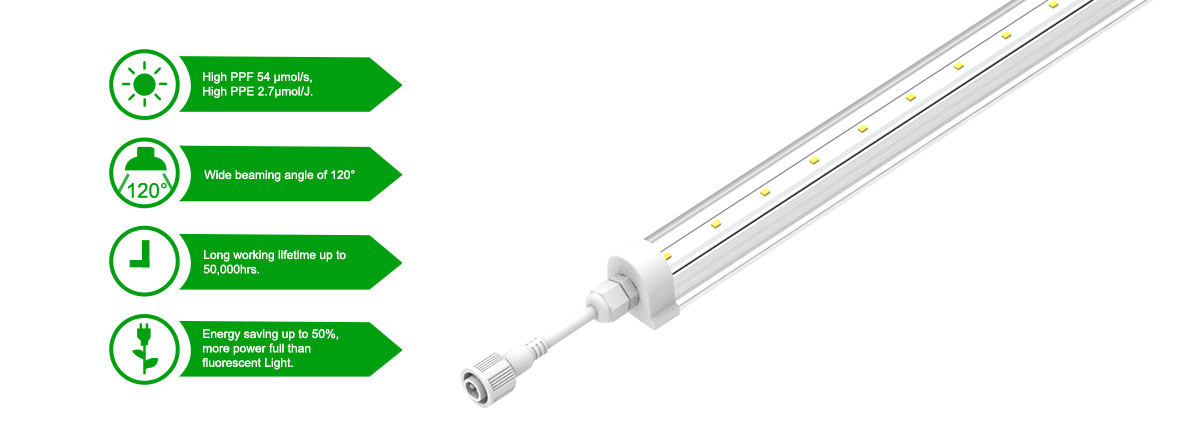To optimize yield and quality in leafy vegetable cultivation, choosing the appropriate light source is crucial. In collaboration with gardening partners worldwide, VANQ offers tailored lighting solutions to meet the unique requirements of each leafy vegetable cultivation. With LED grow lights, leafy vegetables can enjoy an optimal illumination environment.
Here are the advantages of LED plant growth lights:
Mature light recipes for different crops
Energy efficiency
Improved growth quality
Enhanced taste and nutrition
Shorter growth cycles
Environment-friendly

VQ-GLT8W20, a 20W leafy vegetable planting light, is specifically designed for modern agriculture. Its flexible installation facilitates maintenance and replacement while allowing up to 20 units to be connected in series, ideal for large-scale applications. With an IP65 waterproof rating, it adapts to various environments, and its plastic surface prevents electric shock. Customized lengths cater to different planting needs, while its aluminum alloy material ensures efficient heat dissipation and extended service life.
Specifications:
PPF: 54 μmol/s
Efficacy: 2.7 μmol/J
Dimensions: 47in L x 1.25in W x 1.25in D
IP Rating: IP65
How to Achieve Better Leafy Vegetable Yields and Quality at Home?

For optimal leafy vegetable growth, choose the appropriate light spectrum and intensity while controlling illumination time (photoperiod) with a controller.
Light Spectrum
Full-spectrum LED grow lights are the top choice for leafy vegetable cultivation, providing a natural light spectrum that fulfills plants' needs at different growth stages, covering all wavelengths from ultraviolet to infrared.
Light Intensity
Light intensity, or Photosynthetic Photon Flux Density (PPFD), is a crucial parameter affecting photosynthesis. Although light intensity requirements vary among leafy vegetables, a PPFD of 200 μmol/(㎡·s) generally satisfies most plants' growth needs. Keep light intensity below the saturation point to avoid potential harm to plants.
Light intensity and photosynthesis rate increase proportionally below the saturation point, resulting in higher yields.
Below are common PPFD requirements:
Vegetable | PPFD |
Lettuce | 850 μmol/(㎡·s) |
Strawberry | 320 μmol/(㎡·s) |
Ginseng | 50 μmol/(㎡·s) |
Mushroom | 150 μmol/(㎡·s) |
Tomato | 850 μmol/(㎡·s) |
Photoperiod
The photoperiod involves alternating light and dark periods. Each plant has unique needs, and here are some common photoperiod requirements for leafy vegetables:
Lettuce
Lettuce is extremely sensitive to photoperiod and requires 16 hours of light and 8 hours of darkness for robust growth. This balance between photosynthesis and nighttime respiration ensures optimal conditions.
Strawberry
Strawberries are also common in leafy vegetable cultivation and have specific requirements. They grow best with a 12-hour light and 12-hour dark photoperiod, promoting effective photosynthesis, timely flowering, and increased sweetness and yield.
Ginseng
Ginseng is a plant that needs extended light exposure, requiring up to 18 hours of light. This duration ensures robust root growth and high yield with medicinal value.
Tomato
Tomatoes require 14 hours of light and 10 hours of darkness, allowing for sufficient photosynthesis and metabolic processes during the dark period. Experiments show that this photoperiod leads to high yield and improved fruit quality
























